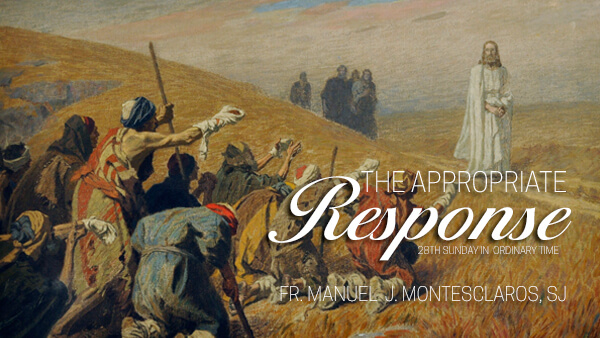


Fr. Manuel J. Montesclaros, SJ
28th Sunday in Ordinary Time
October 9, 2016
Lepers are supposed to keep their distance from the community. Their disease makes them unclean, making them live a life of alienation. Crying to Jesus for mercy is an appeal to cleanse their body and to bring them back into the community.
John Shea noted the fact that there are ten lepers and only one, a foreigner at that, comes back reminds us of the woman who seeks one lost coin out of ten or the shepherd who searches for one lost sheep out of a hundred in Luke 15:3-10. These stories of the lost being found portray the wonder of God’s restlessness to seek the lost. However, the story of one out of ten lepers returning in thanksgiving portrays but one response to the relentless pursuit of God for the lost ones.
Why did Jesus command the lepers to “Go and show yourselves to the priests?” Jewish priests are the guardians of purity of the community. If the priests declare them clean, they can go back to the community. Their life of isolation is over. This shows us that their leprosy is not simply a physical illness. Worse, it cuts them off from the life of the community.
John Shea further explained that “Being cured on the way” is a literary device to bring the ten lepers to a crucial decision: to seek approval of the priests and thus be brought back to the established Jewish community or to praise God, thank Jesus and to now belong to His company, to be among those who give an appropriate response to the new saving action of God in Jesus.
One of the ten, a Samaritan, decided to go back to Jesus, “glorifying God in a loud voice;
and he fell at the feet of Jesus and thanked him.” Jesus calls this response of the Samaritan as faith. He affirms that it is his faith that has saved him.
What is this appropriate response called faith?
The faith of the Samaritan enables him to see in Jesus the divine presence and God’s saving action that sets people free. The recognition leads him to praise and thanksgiving, taking him into a new relationship with God in Jesus. This recognition is contrasted to the response of the nine who have decided instead to seek the approval of the priests and be reinstated into the life of the community. They have missed the opportunity to enter into a new relationship with God in Jesus.
Falling at the feet of Jesus signifies more than reverential worship. It brings the image of a disciple at his master’s feet, like Mary who has chosen the good portion, a portion that will not be taken away from her (Luke 10:41). It speaks of the faith commitment to follow Jesus on the way to Jerusalem. In Luke’s Gospel, Jesus is portrayed as resolute of his journey to Jerusalem. Along the way he encounters ambivalent human response. Praise and gratitude are but an initial important response. It has to blossom into a new way of life as a faithful follower of Jesus along the way of the cross to the glory of his resurrection. Jesus’ command to the newly cleansed Samaritan leper, “Stand up and go,” is instructive. It is a command to make a definitive choice from his faith that has saved him, i.e., to follow Jesus “the dawn from on high, shining on those who live in darkness and in the shadow of death, guiding our feet into the path of peace.” (Luke 1:78)
This reflection is based on John Shea’s Spiritual Commentary “Seizing Second Chances” in Luke Year C The Relentless Widow: The Spiritual Wisdom of the Gospels for Christian Preachers and Teachers (Liturgical Press, 2006), 284-288.